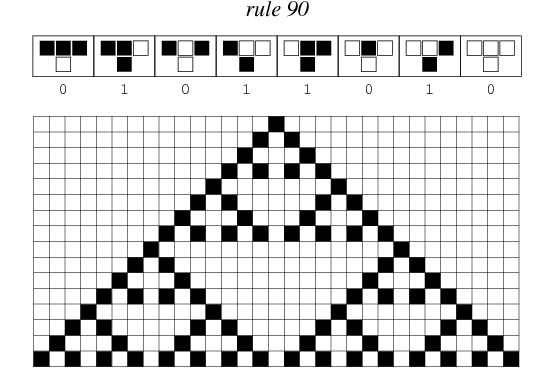HBLbits_Verilog Basic_Rule90
Rule 90
Rule 90 is one of the elementary cellular automaton rules introduced by Stephen Wolfram in 1983 (Wolfram 1983, 2002). It specifies the next color in a cell, depending on its color and its immediate neighbors. Its rule outcomes are encoded in the binary representation ![]() . This rule is illustrated above together with the evolution of a single black cell it produces after 15 steps (Wolfram 2002, p. 55).
. This rule is illustrated above together with the evolution of a single black cell it produces after 15 steps (Wolfram 2002, p. 55).
Starting with a single black cell, successive generations are given by interpreting the numbers 1, 5, 17, 85, 257, 1285, 4369, 21845, ... (OEIS A038183) in binary, namely as 1, 101, 10001, 1010101, 100000001, ... (OEIS A070886).
Rule 90 is amphichiral, and its complement is rule 165.

The fractal produced by this rule was described by Sierpiński in 1915 and appearing in Italian art from the 13th century (Wolfram 2002, p. 43). It is therefore also known as the Sierpiński sieve, Sierpiński gasket, or Sierpiński triangle. The binomial coefficient ![]() mod 2 can be computed using the XOR operation
mod 2 can be computed using the XOR operation ![]() XOR
XOR ![]() , making Pascal's triangle mod 2 very easy to construct. Moreover, coloring all odd numbers black and even numbers white in Pascal's triangle produces a Sierpiński sieve (Guy 1990; Wolfram 2002, p. 870).
, making Pascal's triangle mod 2 very easy to construct. Moreover, coloring all odd numbers black and even numbers white in Pascal's triangle produces a Sierpiński sieve (Guy 1990; Wolfram 2002, p. 870).

Rule 90 is one of the eight additive elementary cellular automata (Wolfram 2002, p. 952).
In the case of Rule 90, each cell's new value is the exclusive or of the two neighboring values. Equivalently, the next state of this particular automaton is governed by the following rule table:[1]
| current pattern | 111 | 110 | 101 | 100 | 011 | 010 | 001 | 000 |
|---|---|---|---|---|---|---|---|---|
| new state for center cell | 0 | 1 | 0 | 1 | 1 | 0 | 1 | 0 |
Rule 90 is a one-dimensional cellular automaton with interesting properties.
The rules are simple. There is a one-dimensional array of cells (on or off). At each time step, the next state of each cell is the XOR of the cell's two current neighbours. A more verbose way of expressing this rule is the following table, where a cell's next state is a function of itself and its two neighbours:
| Left | Center | Right | Center's next state |
|---|---|---|---|
| 1 | 1 | 1 | 0 |
| 1 | 1 | 0 | 1 |
| 1 | 0 | 1 | 0 |
| 1 | 0 | 0 | 1 |
| 0 | 1 | 1 | 1 |
| 0 | 1 | 0 | 0 |
| 0 | 0 | 1 | 1 |
| 0 | 0 | 0 | 0 |
(The name "Rule 90" comes from reading the "next state" column: 01011010 is decimal 90.)
In this circuit, create a 512-cell system (q[511:0]), and advance by one time step each clock cycle. The load input indicates the state of the system should be loaded with data[511:0]. Assume the boundaries (q[-1] and q[512]) are both zero (off).





沒有留言:
張貼留言